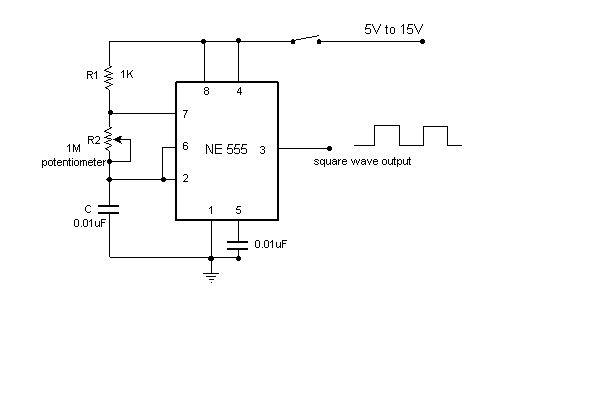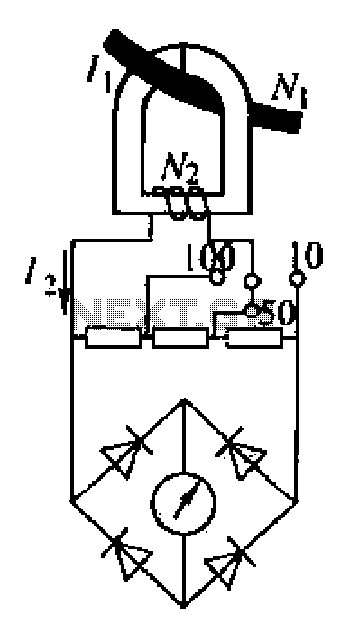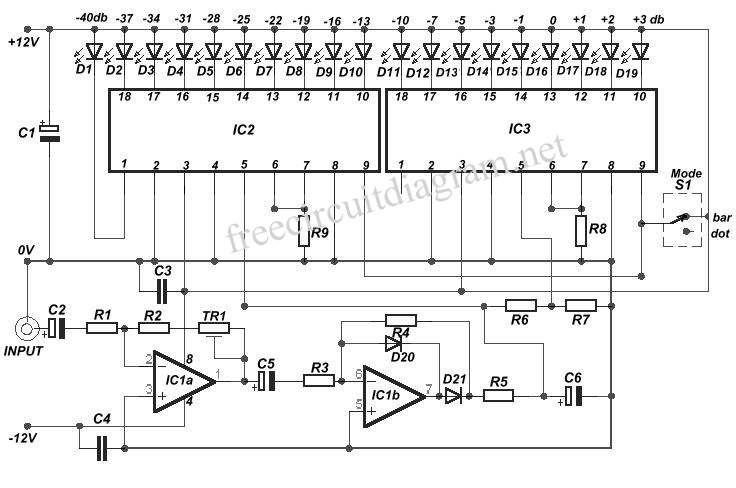
HETERODYNE FREQUENCY METER

The circuit includes a 1-2 MHz oscillator (Q1), an untuned mixer (X1), and an audio frequency beat-note amplifier (Q2). Capacitor C4 is calibrated to display frequency readings directly from 1 to 2 MHz when using an accurate unmodulated RF signal generator. After the calibration process, an unknown RF signal input frequency is introduced into the meter for zero-beating with the harmonics of the calibrated oscillator. A magnetic headphone is connected to J1 to make the beat note audible. When operating at the second harmonic, the dial of C4 ranges from 2 to 4 MHz; at the twentieth harmonic, the coverage extends from 20 to 40 MHz. Inductor L1 consists of 65 turns of No. 28 enamel wire wound on a 1-inch form, with a tap at 20 turns from ground. Inductor L2 comprises 10 turns of No. 28 enamel wire wound closely around the center of L1.
The circuit is designed to operate within a frequency range of 1 to 40 MHz, utilizing a combination of oscillation and mixing techniques to detect and analyze RF signals. The oscillator (Q1) generates a stable frequency output, which serves as a reference for the untuned mixer (X1). The mixer facilitates the combination of the unknown RF signal with the oscillator's output, producing an intermediate frequency that can be processed by the audio frequency beat-note amplifier (Q2).
The calibration of capacitor C4 is critical for accurate frequency measurement. It allows for direct readings of the oscillator frequency, ensuring that the system can effectively zero-beat with the incoming RF signal. The zero-beating technique is essential for identifying the frequency of the unknown signal, as it relies on achieving a condition where the beat frequency is minimized, resulting in an audible tone through the connected magnetic headphones.
The use of inductors L1 and L2 is significant in the circuit's design. L1, with its 65 turns, provides the necessary inductive reactance to facilitate the mixing process, while L2, with its 10 closely wound turns, enhances the circuit's performance by improving the coupling between the oscillator and the mixer. The tapping of L1 at 20 turns allows for flexibility in tuning and adjusting the circuit to achieve optimal performance across the specified frequency ranges.
Overall, this circuit exemplifies a practical application of RF technology in signal detection and analysis, making it a valuable tool for engineers and technicians working in the field of electronics. Its straightforward design and calibration process make it accessible for various applications, including communication systems and signal processing tasks.Circuit consists of 1-2 MHz oscillator Q1, untuned mixer X1, and AF beat-note amplifier Q2. C4 is calibrated to read directly in frequency from 1 to 2 MHz, using accurate unmodulated RF signalgenerator. After calibration, unknown RF signal input frequency is fed into meter for zero-beating with harmonics of calibrated oscillator.
Magnetic headphone s plugged into J1 make beat note audible. On second harmonic, dial of C4 covers 2-4 MHz; on twentieth harmonic, coverage is 20-. 40 MHz. L1 is 65 tums No. 28 enamel on 1-inch form, tapped 20 tums from ground. L2 is 10 tums No. 28 enamel closewound around center of L1. -R. P. Turner, "FET Circuits, " Howard W. Sams, Indianapolis, IN, 1977, 2nd Ed. , p 144-146. 🔗 External reference
The circuit is designed to operate within a frequency range of 1 to 40 MHz, utilizing a combination of oscillation and mixing techniques to detect and analyze RF signals. The oscillator (Q1) generates a stable frequency output, which serves as a reference for the untuned mixer (X1). The mixer facilitates the combination of the unknown RF signal with the oscillator's output, producing an intermediate frequency that can be processed by the audio frequency beat-note amplifier (Q2).
The calibration of capacitor C4 is critical for accurate frequency measurement. It allows for direct readings of the oscillator frequency, ensuring that the system can effectively zero-beat with the incoming RF signal. The zero-beating technique is essential for identifying the frequency of the unknown signal, as it relies on achieving a condition where the beat frequency is minimized, resulting in an audible tone through the connected magnetic headphones.
The use of inductors L1 and L2 is significant in the circuit's design. L1, with its 65 turns, provides the necessary inductive reactance to facilitate the mixing process, while L2, with its 10 closely wound turns, enhances the circuit's performance by improving the coupling between the oscillator and the mixer. The tapping of L1 at 20 turns allows for flexibility in tuning and adjusting the circuit to achieve optimal performance across the specified frequency ranges.
Overall, this circuit exemplifies a practical application of RF technology in signal detection and analysis, making it a valuable tool for engineers and technicians working in the field of electronics. Its straightforward design and calibration process make it accessible for various applications, including communication systems and signal processing tasks.Circuit consists of 1-2 MHz oscillator Q1, untuned mixer X1, and AF beat-note amplifier Q2. C4 is calibrated to read directly in frequency from 1 to 2 MHz, using accurate unmodulated RF signalgenerator. After calibration, unknown RF signal input frequency is fed into meter for zero-beating with harmonics of calibrated oscillator.
Magnetic headphone s plugged into J1 make beat note audible. On second harmonic, dial of C4 covers 2-4 MHz; on twentieth harmonic, coverage is 20-. 40 MHz. L1 is 65 tums No. 28 enamel on 1-inch form, tapped 20 tums from ground. L2 is 10 tums No. 28 enamel closewound around center of L1. -R. P. Turner, "FET Circuits, " Howard W. Sams, Indianapolis, IN, 1977, 2nd Ed. , p 144-146. 🔗 External reference





